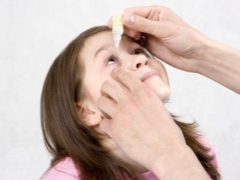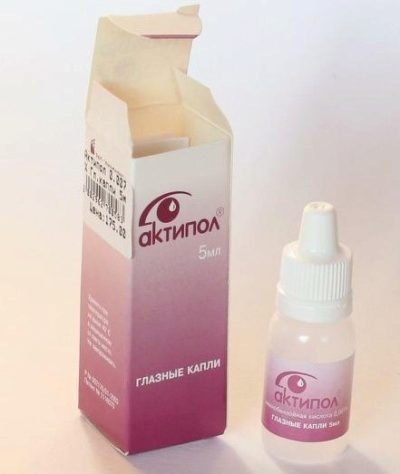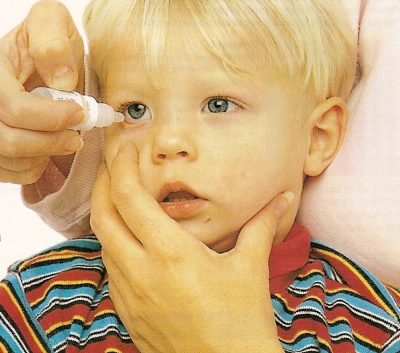Antiviral eye drops for children
Viral infections are insidious. The virus can enter the body of the child not only through the nasopharynx, although this is the most frequent way, but sometimes through the mucous membrane of the eyes. In addition, eye diseases can accompany a number of viral infections that children get sick quite often.
In this case, antiviral eye drops for children may be needed. What are they, how to choose them and how to use them? Will try to understand these issues.
When required?
- In infectious diseases of the organs of vision. With diagnoses that are confirmed by an ophthalmologist. It may be adenoviral. conjunctivitis, herpetic eye disease, cytomegalovirus inflammation, etc.
- In viral diseases as a separate symptom. Often, the mucous membrane of the child’s eyes becomes inflamed in cases of measles, chickenpox, rubella, and infectious mononucleosis and other unpleasant illnesses caused by viruses.
When can not apply?
- Antiviral eye drops should not be used if the infection is exclusively bacterial, caused by microbes in the eyes (staphylococci, Pseudomonas aeruginosa, and others). This must be confirmed by an ophthalmologist.
- Antiviral drops can harm a child if the blood test of a young patient has shown a significant decrease in the level of white blood cells and platelets.
- If the child has kidney and liver diseases, serious psychiatric abnormalities, severe allergic reactions.
- If the baby suffers from epilepsy.
How to act?
Antiviral eye drops in the eye act locally, increasing the production of interferon protein in the mucous membrane of the organ of vision. This protein is essential for the activation of immunity and the ultimate victory over the virus.
Some types of droplets incorporate ready-made interferons obtained from donor blood cells, animal biomaterials by gene engineers, but such preparations in children can cause many side effects.
There is another type of droplets - virucidal chemical compounds that destroy the virus on their own.
How to bury eye drops for children? Tips ophthalmologist.
Very often, a bacterial complication is added to the viral inflammation of the eye, the eye may begin to fester, for example. Then the doctor will reasonably offer to add drops or antibiotic ointment to antiviral drops and give the appropriate prescription.
Drug List
- "Ganciclovir". Drops, which are well help with diseases of the organs of vision caused by cytomegalovirus and herpes virus. Antiviral drug was developed by scientists from Canada. Effective drug inside the virus - is embedded in its DNA and prevents further synthesis. Due to the long list of possible negative effects from taking the drug, these drops are not recommended for children under 12 years old. But doctors sometimes prescribe this medicine in small individual doses.
- «Ophthalmoferon». Drops that are effective against many viruses, because they fall into the category of extended-spectrum antiviral drugs. In addition to combating viruses, Ophthalmoferon moderately anesthetizes and promotes regeneration (recovery) of the mucous membrane. The drug can be prescribed for the treatment of adenoviral and enteroviral conjunctivitis, kerotitis, herpes infections of the eye.The drug is quite suitable for use in children of different ages - from newborns to adolescents. In the acute phase of inflammation, 2 droplets drop into each eye 6-8 times a day. As you recover, the number of instillations is reduced to 3 per day.
- "Poludan". Antiviral drops that stimulate the production of endogenous interferon. Appointed with the defeat of the eyes that accompany the flu, acute respiratory viral infections, with herpetic lesions and viral conjunctivitis. In pharmacies "Poludan" you can buy as a dry substance in a vial, from which it is quite easy to prepare a solution for instillation at home.
For this, boiled chilled water is added to the container to the mark on the bottle. Stir thoroughly. The finished solution should be stored in the refrigerator. To drip "Poludan" it is necessary strictly in a conjunctival sac (space between a century and an eyeball). With severe inflammation, the child needs to drop 2-3 drops 6-8 times a day, when the condition improves, the number of instillations is reduced to 2-3. The drug due to low toxicity is recommended for children of all age groups.
- "Aktipol". Antivirus immunomodulator for local use. Accelerates the formation of the body's own interferon, which fights against viruses. In addition, "Aktipol" restores the damaged cornea. Drops prescribed for viral conjunctivitis, herpes infection of the organs of vision.
During a strong inflammatory process, the child needs to drop 1-2 drops 8 times a day. Then, when the healing process begins, the dose is reduced to 2 drops three times a day for a week. Pharmacies sell ready-to-use drops. You can give them to children of any age.
- "Oftan Idu." These drops are often used for viral eye diseases, but they are not antiviral by themselves. This is a glucocorticosteroid for topical use. "Oftan" has anti-inflammatory action. Drops 1-2 drops three times a day strictly as prescribed by a doctor. Manufacturers do not position the drug as a child, because there is not enough clinical data on its effect on the children's body. But in pediatric practice, this drug takes its place and can be prescribed to the child, of course, not in infancy. Most often, the medicine is prescribed for children from 6 years and older.
- Gludantan. These eye drops can be used for inflammation of the eyes with influenza type A. The drug is not antiviral, but is often prescribed for adenoviral conjunctivitis, epidemic keratoconjunctivitis.
Sometimes there is a need to use eye ointment instead of drops. This is true for children with allergies and in cases where the drops were ineffective. Children are prescribed antiviral eye ointments. "Acyclovir"Gel" Zirgan ".
Conjunctivitis - School of Doctor Komarovsky - all parents need to know this!
General recommendations for use
- You can not assign drops to the child alone. Only a specialist can assess the degree of eye damage, possible consequences and risks. An urgent need to visit a child ophthalmologist.
- Before instillation, it is necessary to free the child’s eyes from crusts, pus and other secretions. To do this, you can use boiled water, a solution of furatsilina, a weak decoction of chamomile. Washing should be done with warm solutions, wetting cotton pads in them. For each eye, a separate cotton pad!
- Drops should be warm, warm the bottle in your hands before use. This will bring less discomfort to the child.
- If an allergic reaction occurs (more redness, eyelid swelling or increased swelling, itching, tearing), antiviral drops should be immediately canceled. And again go to the doctor for the appointment of another drug.




















